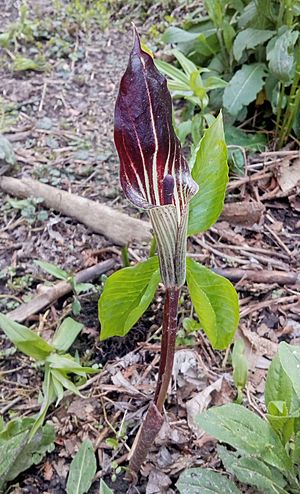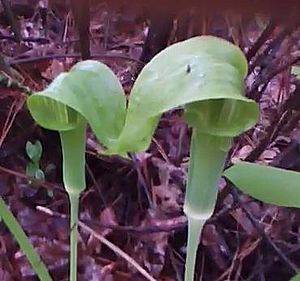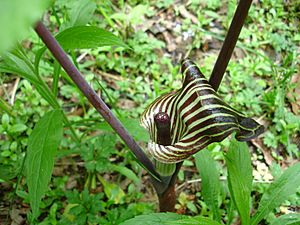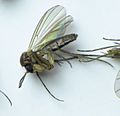Jack-in-the-pulpit facts for kids
Quick facts for kids Jack-in-the-pulpit |
|
|---|---|
 |
|
| Arisaema triphyllum blooming in Bob Hunter Memorial Park. | |
| Conservation status | |
| Scientific classification | |
| Genus: |
Arisaema
|
| Species: |
triphyllum
|
| Synonyms | |
|
|
Arisaema triphyllum, also known as jack-in-the-pulpit, bog onion, brown dragon, or Indian turnip, is a fascinating plant. It's a herbaceous perennial plant, meaning it grows back every year from a special underground stem called a corm. This plant usually grows about 30–65 centimetres (12–26 in) tall. It has leaves divided into three parts and unique flowers hidden inside a hood-like structure. Jack-in-the-pulpit grows naturally in eastern North America, often found in damp forests and bushy areas. You can find it from Nova Scotia in Canada, west to Minnesota, and south all the way to Florida and Texas.
Contents
What Jack-in-the-Pulpit Looks Like

The leaves of the jack-in-the-pulpit are made of three separate leaflets. These three leaflets grow together at the top of one long stem, which comes from the corm. Each leaflet is about 8–15 centimetres (3.1–5.9 in) long and 3–7 centimetres (1.2–2.8 in) wide. Sometimes, people can confuse young jack-in-the-pulpit plants with poison ivy, especially before the flowers appear. Remember, poison ivy also has three leaflets!
The plant's flowers are quite special. They are shaped unusually and can grow up to 8 cm long. They are usually greenish-yellow, but sometimes they are fully green with purple or brownish stripes. The part that looks like a hood is called the "spathe." This spathe wraps around and covers the "Jack," which is a central stalk called a spadix. The spadix is covered with many tiny flowers.
How Jack-in-the-Pulpit Reproduces
The flowers on the spadix are unisexual, meaning they are either male or female. Interestingly, jack-in-the-pulpit plants are sequential hermaphrodites. This means they can change their sex! Smaller, younger plants usually have mostly male flowers. As the plant gets older and grows larger, its spadix starts to produce more female flowers.
This plant flowers from April to June. It is pollinated by tiny insects called fungus gnats. The plant attracts these gnats with its smell. The flower acts like a trap. Fungus gnats can escape from male flowers, but they get stuck inside female flowers. Other insects, like gall gnats and beetles, also visit the flowers.
The plant cannot pollinate itself. The male flowers on one plant mature and die before the female flowers on the same plant are ready. So, female flowers need to be pollinated by male flowers from a different plant. This helps keep the plant species healthy by preventing inbreeding.
After pollination, the plant produces fruits. These are smooth, shiny green berries that are about 1 cm wide. They grow in a cluster on the thickened spadix. The fruits ripen in late summer and fall, turning a bright red color. Each berry usually has 1 to 5 seeds. The seeds are white to light tan, rounded, and often have flattened edges. If the seeds are released from the berry, they will sprout the next spring. They start as a small plant with just one rounded leaf. It takes about three or more years for a seedling to grow big enough to produce flowers.
Jack-in-the-pulpit is a tough plant. It can survive cold winters, even in USDA plant hardiness zone 3.
Plant Chemistry and Traditional Uses
Every part of the jack-in-the-pulpit plant contains tiny, needle-shaped crystals called calcium oxalate raphides. Because of these crystals, eating the raw plant will cause a strong burning feeling in your mouth. It can irritate your mouth and stomach. In rare cases, it can even cause your mouth and throat to swell, which might make it hard to breathe. So, it's very important not to eat the raw plant!
However, if the plant is cooked properly, it can be eaten like a root vegetable. The calcium oxalate crystals give it a peppery taste. If the plant is sliced and then dried, it can be eaten like potato chips or ground into a flour.
Historically, some Native American groups used parts of the jack-in-the-pulpit. For example, a preparation made from the root was reported to be used to treat sore eyes. Other preparations were used for things like rheumatism, bronchitis, and even snakebites. Some also used it to try and prevent pregnancy.
History and Folklore
The Meskwaki people, a Native American tribe, had interesting stories and uses for this plant. One account says they would chop the plant's corm, mix it with meat, and leave it for their enemies to find. The strong taste of the plant's chemicals would be hidden by the meat. It was believed that eating this mixture would cause pain and even death. This story shows how powerful and dangerous the plant was known to be.
The Meskwaki also reportedly used the plant to tell if a sick person would get better. They would drop a seed into a cup of stirred water. If the seed spun around four times clockwise, it meant the patient would recover. If it spun less than four times, it was believed they would not.
Safety and Similar Plants
The oxalic acid in jack-in-the-pulpit is poisonous if you eat it. Always remember that this plant should not be eaten raw.
Also, be careful not to confuse jack-in-the-pulpit with poison ivy. Both plants have leaves with three leaflets, especially when they are young. Always be sure you know what plant you are looking at before touching or handling it.
Plant Classification
Arisaema triphyllum is usually seen as one species with three main types, or subspecies. These are A. t. stewardsonii, A. t. pusillum, and A. t. triphyllum. The A. t. triphyllum type is special because it has twice as many sets of chromosomes (it's a tetraploid) and is thought to have come from a mix of the other two types. Even though they are called subspecies, these three types don't usually mix in nature, which suggests they could be considered separate species. It's often hard to tell them apart just by looking at dried plant samples.
Within the larger group of Arisaema plants, A. triphyllum belongs to a section called Pedatisecta. It is most closely related to some Asian species, like A. amurense. Interestingly, it is not closely related to other Arisaema species found in America, such as A. dracontium and A. macrospathum. Those are in a different part of the Arisaema family tree.
Images for kids
See also
 In Spanish: Arisaema triphyllum para niños
In Spanish: Arisaema triphyllum para niños









